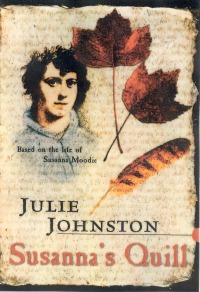| ________________
CM . . .
. Volume XI Number 2 . . . . September 17, 2004
excerpt:
With Susanna's Quill, Johnston, twice the recipient of the Governor General's Literary Award for Juvenile Fiction, turns to a challenging genre, biographical fiction, one in which the writer's freedom to create plot is constrained by the large facts of the subject's life. Johnston has also chosen the author Susanna Moodie [1803-1885] as her subject, someone not likely known to most Canadian adolescents. Nonetheless, the book's very episodic "plot" will appeal to girls who like historical fiction, especially that which concerns itself with social history. Johnston divides her book into three parts with the first beginning in 1814, when Susanna, the youngest of six daughters and the third youngest of eight children in the middle-class Strickland family, is living at Reydon Hall, an Elizabethan manor house near Southwold in Suffolk, England. The second portion commences in 1832 as a pregnant Susanna and her husband, Lieutenant John Moodie, six years her senior, arrive in Canada and take up residence on a rough farm "about eight miles from the village of Cobourg, and four miles from Port Hope" in Upper Canada. Part Three starts in February,1834, as the Moodies, the family now enlarged by two daughters, move some fifty miles to an undeveloped land grant near Lakefield where two of the neighbouring families are Susanna's brother Samuel Strickland and her sister Catharine, now Mrs. Traill. This section concludes in 1839 as the Moodies, their family having grown to five children, permanently leave the backwoods to take up residence in Belleville where John was to become the sheriff for Hastings County. Each section is introduced by an entry written by Susanna and dated "Belleville, 1849," and the book concludes with a similar entry. Though each chapter could almost stand on its own as a separate read, the book's three parts tell contrasting "stories" which ultimately yield an engaging whole. The opening section provides the social setting in which Susanna was raised, one in which class was important and those with wealth and standing had servants. It also shows what the expectations of "ladies" were in England's polite social circles. The middle section reveals how the Moodies brought their class values to Canada and how ill-suited these genteel values were to achieving the skills and knowledge demanded by this rough new country. In the concluding section, readers see how Susanna had ultimately adapted to the hardships of her adopted country. Running through all three sections are the almost overwhelming challenges Susanna must constantly overcome as she strives to be an author. A cover note says that the book is "Based on the life of Susanna Moodie," and, Johnston, in her opening "Author's Note," explains that she has utilized both real characters and events but has also invented some of both. As well, she states, "I have quoted parts of actual letters, combining them with my own work." Perhaps some end notes could have been added to assist readers in sorting out those portions of fact from the fiction. Rich in period details that should make most of today's adolescents happy that they live in twenty-first century Canada and not in Susanna's labor intensive times, Susanna's Quill is a most readable introduction to an important nineteenth-century Canadian writer. Undoubtedly, some readers will be so intrigued by Johnston's work that they will seek out Susanna's Roughing It in the Bush. Recommended. Dave Jenkinson teaches courses in YA literature in the Faculty of Education, the University of Manitoba in Winnipeg, MB.
To comment
on this title or this review, send mail to cm@umanitoba.ca.
Copyright © the Manitoba Library Association. Reproduction for personal
use is permitted only if this copyright notice is maintained. Any
other reproduction is prohibited without permission.
NEXT REVIEW |TABLE OF CONTENTS FOR THIS ISSUE
- September 17, 2004.
AUTHORS
| TITLES | MEDIA REVIEWS
| PROFILES
| BACK ISSUES
| SEARCH | CMARCHIVE
| HOME |
